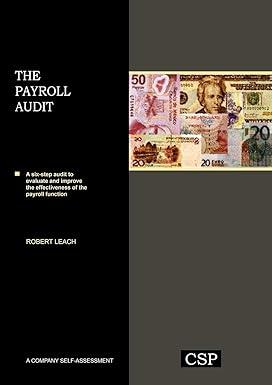Question
Please answer the True/ False questions _____ 1. Regular corporations are free to choose any fiscal or calendar year as their tax year. _____ 2.
Please answer the True/ False questions
_____ 1. Regular corporations are free to choose any fiscal or calendar year as their tax year.
_____ 2. The tax rate on corporate income from $100,000 to $335,000 is a rate higher than for any other increment of corporate income.
_____ 3. Corporations are allowed a charitable contribution deduction equal to 10% of gross profit.
_____ 4. A corporation can elect to carry a capital loss back first to the third preceding tax year before it is carried forward five years, but it would otherwise only carry the capital loss forward.
_____ 5. In 2011, a corporations deduction for qualified U.S. production activities is 9% of qualified production activities income up to a maximum of 50% of wages paid during the year.
_____ 6. A corporate net operating loss can be carried forward indefinitely after being carried back two years.
_____ 7. A corporation is allowed a general business credit, but the credit cannot reduce the tax liability to zero.
_____ 8. The Schedule L of Form 1120 is a corporate balance sheet as determined by the tax laws.
_____ 9. The corporate alternative tax is paid in place of the regular corporate income tax.
_____ 10. The unextended due date for a corporate tax return is the 15th day of the third month after the close of its tax year.
_____ 11. All corporations whose income tax liability is less than $1,000,000 in the current year can avoid an underpayment penalty if each of their estimated tax payments is 25 percent or more of their immediately preceding tax years tax liability.
_____ 12. In determining consolidated net income, each corporation first must compute separate taxable income.
_____ 13. Intercompany dividends are one of many items eliminated in preparing a consolidated tax return.
_____ 14. A corporation that only has accumulated earnings and profits cannot make a dividend distribution.
_____ 15. If property is distributed to a shareholder as a dividend, the dividend is equal to the propertys fair market value.
Step by Step Solution
There are 3 Steps involved in it
Step: 1

Get Instant Access to Expert-Tailored Solutions
See step-by-step solutions with expert insights and AI powered tools for academic success
Step: 2

Step: 3

Ace Your Homework with AI
Get the answers you need in no time with our AI-driven, step-by-step assistance
Get Started


